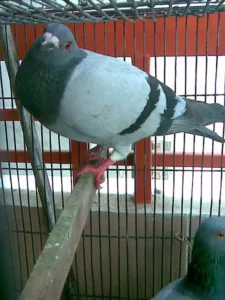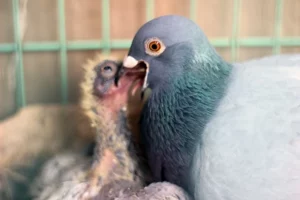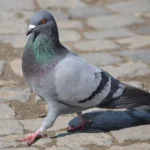Among different pigeons, racing pigeons are fascinating. These pigeons are famed for flying far and high. Let’s look at their top features below.
| Breed name | Racing Homer |
| Breed class | Average |
| Special features | Hardy, active, excellent flying capacity, beautiful. |
| Flying ability | Excellent |
| Purpose | Flying and pigeon racing show |
| Eyes | Clean and not faded |
| Eye colors | Red, brown, orange, yellow, or gray |
| Colors | Several |
| Body structure | Slim and slender |
| Neck | Short and stout |
| Chest | Wide |
| Sexual maturity | At 6 months |
| Can be kept as pets | Yes |
| Origin of the fastest racing pigeon breed | Belgium |
| Distance coverage | 100-1000 km |
| Average speed | 60 mph |
| Average lifespan | Up to 20 years |
What is a racing pigeon?

Racing pigeons, also known as homing pigeons, are well-known for their excellent flying abilities. They are an ancient racing bird breed with a nearly 3000-year history.
Racing pigeons are domestic pigeons that are descendants of the wild rock dove. Racing pigeons are exceptionally good at navigating long distances to get home. They are, therefore, carefully bred to soar high and compete in pigeon racing events.
It won’t be incorrect to state that racing pigeons have a natural ability to home. Racing pigeons have long been used as model species in research on navigation, and their ability to home has fascinated people across all time. These birds use magnetoreception to navigate through the air to find their way back to their shelter or nest.
Are homer and racing pigeons the same?
Racing and homer pigeons are essentially the same. The only thing separating them is their racing prowess. Based on their racing prowess, racing pigeons are bred specifically for pigeon racing competitions, while “plain homer pigeons” have simply been kept and flown for entertainment.
Additionally, it’s important to keep in mind that while all homers are racing pigeons, not all racing pigeons are homers. Let’s keep it this way, so it’s simple to understand: while homer is the breed, racing is the occupation. So, homers with excellent speed and the best homing instincts are trained and transformed into racing pigeons.
How to identify racing pigeons?
It might not be possible to simply glance at a pigeon and determine that it is a superb specimen. So, the following are a few things to consider when choosing the best racing pigeons.
Head Shape
Let’s start with the pigeon’s head.
A racing pigeon needs to have a head proportionate to the rest of its body. The head should not be too big or small. Additionally, the head area between the eyes and beak shouldn’t be compressed. It should be more rounded and bulging.
Beak
Even though it is not particularly important for racing pigeons, the beak should be proportionate to the rest of the bird’s body. The beak must also be strong and secured to the head. Another factor to consider is that the upper mandible must be bigger than the lower one. Furthermore, the pigeon should also be able to close its beak fully.
Eyes
No specific eye color is required for racing pigeons. Any color, as long as it is vivid, is acceptable, including red, brown, orange, yellow, and gray. In this case, the eye color shouldn’t be faded, and the eyeball beneath the eyelids should be gray or black.
Additionally, the pupil should be shiny and jet black, and the iris’ color shouldn’t be faded. Furthermore, a pigeon can improve its resistance to exhaustion, rain, and air during a race if it has good control over its circle of adaptation.
Overall Body Structure
A racing pigeon’s overall physique should be lean and trim. The pigeon’s chest should be broad and strong, with a slight frontal curve and slight underside sloping. The bird should have a flat, rounded back and a neck that is neither too long nor too thin.
Breastbone
The breastbone of a racing pigeon needs to be sturdy, well-shaped, and substantial enough to support the wing muscles. The breastbone shouldn’t be arched, either.
Wing Shape
Simply put, supple—not quivering, but also not too difficult to open. Additionally, better wings have larger, more robust feathers.
Tail
Pigeons control their movement in the air by turning and balancing on their tails. Therefore, the tail should be thin and not too long. It should be one feather wide when at rest.
Feet
A healthy racing pigeon should possess clean, strong, and agile feet.
How to feed racing pigeons?

Racing pigeons are bird athletes. So, like any human athlete, they will be more likely to achieve their full potential if fed appropriately. So, how to feed racing pigeons?
Racing pigeon diets typically consist of 12–14% protein and 7–15% fat. However, carbohydrates should make up the majority of their diet because birds need them for energy to fly quickly over great distances. Simply put, the racing pigeon diet must have over 3000 kcal per kg of energy.
There shouldn’t be an imbalance in feeding. Doing so will make the race team less competitive because of over- or under-powering. The following table approximates the protein content of the most popular grains. Please carefully combine the grains and add the protein needed for racing.
How to breed racing pigeons?

As winter approaches, pigeon fanciers across the country prepare to pair pigeons with high-performance lineage to get future champions. So, let’s look at how to breed racing pigeons.
Ensure that the pigeons are healthy
First and foremost, winter breeding can be difficult for both the fancier and the pigeons. As a result, ensure that the breeding pair is in good health. One of the best ways to ensure the pigeons’ health is to take them to the vet between late October and early November. The veterinarian will ensure that the pigeons are healthy or require medications.
Clean the loft
It is also critical to keep the breeding pigeons in a clean environment. So, clean the loft, including scraping, vacuuming, and removing any contaminants. Using a disinfectant spray to clean every corner and crevice is also critical.
Appropriate feeding
Gradually transitioning to a breeding mixture is essential. This can be accomplished by gradually transitioning the pigeons from the winter mixture to a breeding mixture at least ten days before breeding. To learn more, ask the veterinarian.
Pre-couple the breeding pair
The breeding pair should be pre-coupled because it has many benefits. This is crucial to prevent any conflicts and promote coupling. Racing pigeons can be pre-coupled by socializing for two to three weeks before the real coupling. The pigeons would be better able to recognize and accept one another as partners after pre-coupling.
Summary
This concludes our discussion of the traits of racing pigeons. We sincerely hope you found the information in this post to be helpful. If you’re also a fan of racing pigeons, check out our blog to learn more about these birds.



